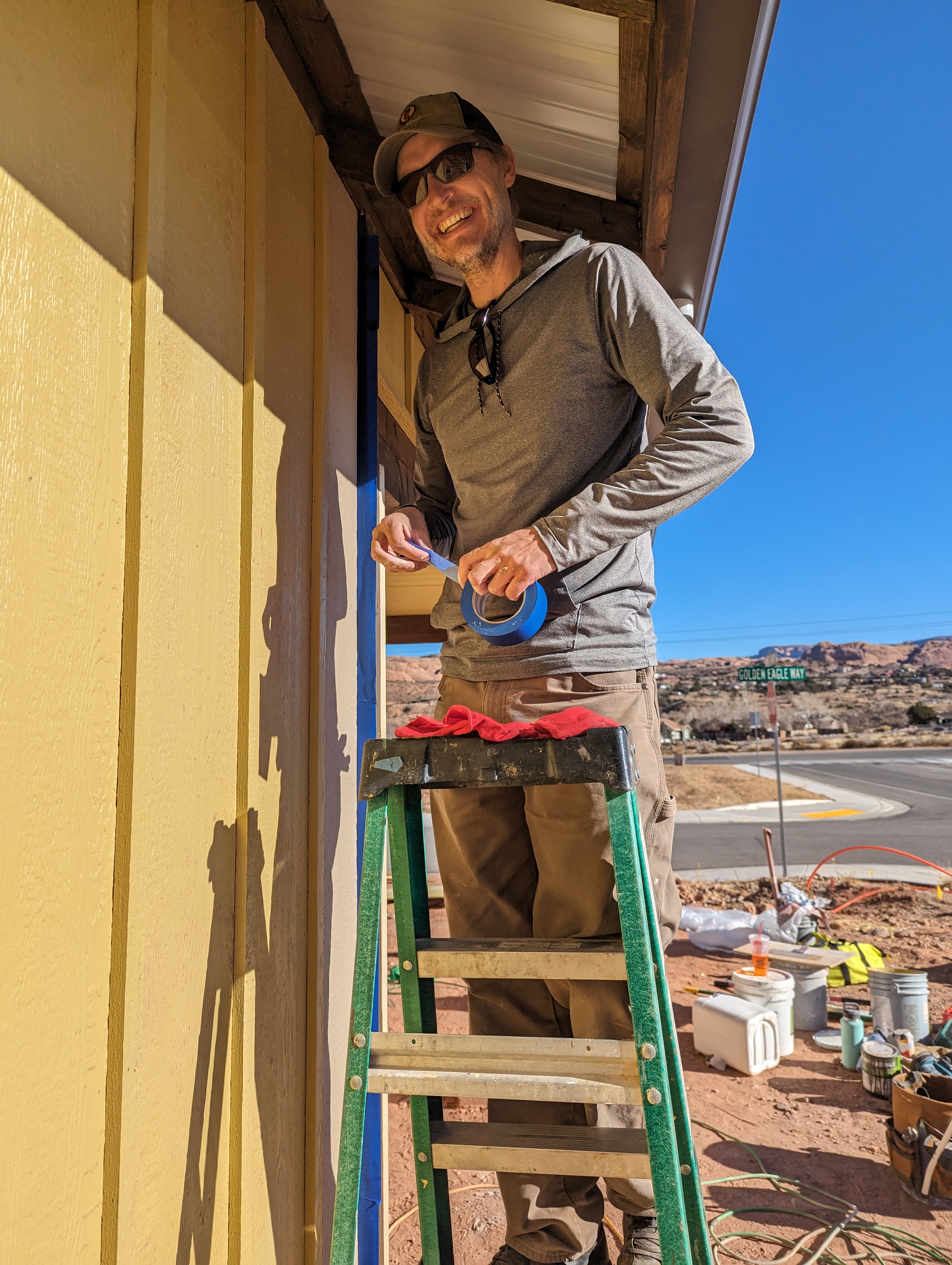Some information may be outdated.
Words of reflection from new residents at Arroyo Crossing
Eight new homeowners showed off their hard work and new homes at Arroyo Crossing to the community during an open house event on Thursday, Dec. 14. However, the homeowners continue to work to get the homes ready to pass inspections.
This batch of homes is the third group of eight built on the Moab Area Community Land Trust with Community Rebuilds, a nonprofit with a mission of building energy-efficient housing while providing educational components for the builders. The nonprofit has built 52 houses in the community so far, according to its website.
The program, in part sponsored by USDA rural development grants and loans, provides new homeowners with an affordable house that is deed-restricted to people living and working in Moab. It is part of a “sweat-equity” program where homeowners dedicate 20 hours each week to working on their homes. Each house has many options for sustainability, from straw bales to solar panels, and all reflect the unique personality of the homeowner.
While the process has felt fast for homeowner Katie Proctor, she says this has been years in the making—from signing up for “the list,” waiting for it to start, to building the house. She said it feels surreal to be moving in.
For Carmelita Jimenez—another homeowner—it’s been intense. Near tears, she said it’s been as equally powerful as it’s been difficult.
“It felt so unobtainable for so long with the housing climate as a single female… to have a home without a partner,” Jimenez said. “I’ve been trying to make every space intentional, make every single decision because it means the world to me.”
She described the process of learning construction skills as a scary thing, but it’s left her changed—she says it’s the most important thing she’s ever done.
“I’ve learned so much,” she said. “I’ve learned to be a better student and how to be a teacher and all of these skills that I never thought I’d have.”
Jimenez said she feels like she’s paving the way for her nieces: in building her own home, she’s reminding them that they can do things on their own and be independent women.
“This has helped me become a person they can look up to,” she said.
For homeowner Tamara Freida, a music teacher, the lessons she’s learned through the process will help her teach students perseverance and frustration tolerance.
She reflected on the frustration of learning new skills at the beginning, and how she’s gained confidence in her ability to learn new things. Applying that to teaching violin and music, she feels a sense of empathy for her students and a deeper understanding of the learning process through this endeavor.
Biologist and new homeowner Cara Lauria is “stoked.” She can’t wait to move in. Standing in front of her adobe wall in her living room, with her partner working on trim, she is positive about the future. She balanced the build with her job by working longer hours during the busy field season to accrue time off so that she could dedicate time to the build.
Community Rebuilds Project Manager Nick Ilhey said every home builder could agree that the process has been a journey. His process of growth included learning to step back and let others do the work, including learning to communicate and teach in this role. His contract will be done at the end of this build, and he looks forward to taking care of himself in ways he’s neglected.
Other homeowners include Tanesha Hartnagle, a registered nurse at the Moab Regional Hospital, Melanie Dennis, U.S. Army veteran Harrison Jelly, and Elizabeth “Izzi” Weimholt, Grand County Weed Department supervisor.
For Community Rebuilds Executive Director Rikki Epperson, “the future is bright.”
CR will continue to build homes in 2024, breaking ground on four homes in the spring. New project managers Brittany Valene and Jessica Retka will work together to lead the builds.
Epperson and Program Manager Nancy Morlock are excited about the new hires. “They are both incredible teachers and skilled builders,” Epperson said. “They have both worked with Community Rebuilds in the past and know what it’s like to be a new building intern on a Community Rebuilds site.”
The programming has come full circle again from Epperson’s perspective. “It’s always great to see the student become the teacher,” she said.
To build a house takes a village. A day on the job site includes a wide range of people from contractors—siders, electricians, painters—to unskilled volunteer labor mostly from homeowners and their friends and family. Americorp volunteer teams come in for seven weeks. AmeriCorps volunteer Taya Wynn from New Zealand said this experience has been “mint–” a common expression in her home country that means “great.” She likes the hands-on experience and going into communities to give back.
For AmeriCorps apprentice Nath Kapoor, this experience has been refreshing and intimate. The pace of the build has been like a “splash of cold water in the face.” Sharing intimate moments with homeowners has been a highlight for Kapoor. He recalled working with a group to install studs in the walls–the homeowner was there too, and will remember the “laughs and stories held in the walls.” The apprentice program places interns on site each day, to share their knowledge from workshops, directing volunteers, and delegating work.
Homeowners can officially move in after a few rounds of inspection conducted by both the county and the USDA, which requires an additional inspection for move-in.
Update: CR Executive Director Rikki Epperson reported that all families are scheduled to move in before the new year. “We’ve been working really hard to get these homes done this week,” she said.
Appreciate the coverage? Help keep local news alive.
Chip in to support the Moab Sun News.





